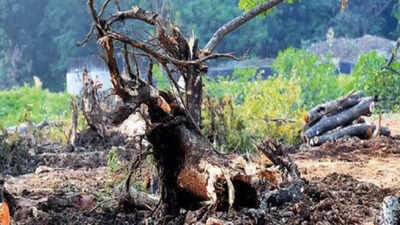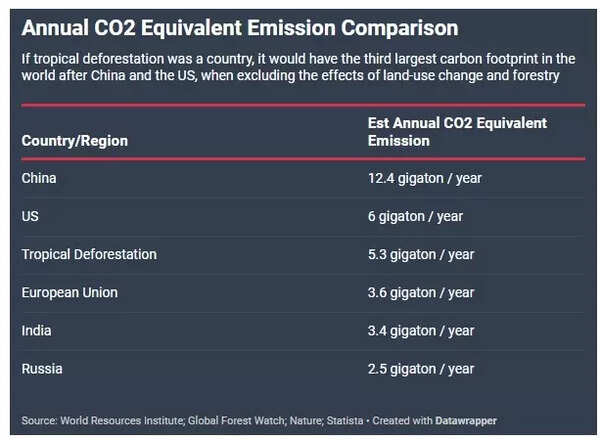- News
- India News
- ‘Tropical deforestation led to nearly 2-gigatons more CO2/year than India’
Trending
This story is from November 4, 2021
‘Tropical deforestation led to nearly 2-gigatons more CO2/year than India’

Representative image
BENGALURU: One of the major takeaways so far at the COP26 in Glasgow has been the pledge — by more than 100 leaders — to end deforestation by the end of this decade. That countries including India have stayed away from this declaration notwithstanding, those who’ve taken the pledge together account for roughly 85% of the world's forests.
While experts and world leaders have been speaking about the need to reduce deforestation as a climate change mitigation strategy, the loss of tree cover has continued to happen across the world.
And, data and imagery from Global Forest Watch analysed in recent research published by the journal Nature earlier this year shows that tropical tree cover loss has led to an average annual CO2 equivalent emissions of 5.3 gigatons between 2001 and 2019.

In fact, if tropical deforestation was a country, it would have the third largest carbon footprint in the world after China and the US, when excluding the effects of land-use change and forestry (see graphic).
The study in Nature, accessed by TOI, has 17 authors/researchers from the US, Netherlands and Indonesia. And, in the conclusion of their study, the authors say: “Our analysis reinforces the need to reduce gross emissions from tropical deforestation as a climate change mitigation strategy, while also highlighting the substantial but often underappreciated contribution of intact primary and older secondary forests to carbon dioxide removals.”
Pointing out that quantifying gross emissions and removals separately and consistently across all forest lands — and producing maps in addition to tabular statistics — improves transparency in accounting of factors and geographies contributing to global net forest GHG flux, they added that it also provides a framework to integrate new and improved data sources over time and that governments interested in spatially prioritizing implementation and tracking of national and subnational forest mitigation targets can increasingly make use of such data.
“Non-government actors, such as companies aiming to reduce emissions from deforestation associated with commodity supply chains and emerging market mechanisms considering the inclusion of forests for carbon offset programmes, could benefit from a globally consistent and spatially explicit forest monitoring system developed using the same internationally accepted methods as national governments use but based on independent observations and with GHG estimates that can be linked to individual actions and generated at scales relevant to diverse climate-related policies, programmes and stakeholders,” the study reads.
They say that as the capacity of national governments to collect, process and analyse data continues to improve, the global forest carbon monitoring framework introduced here can help to enhance transparency, inform forest-related climate policy and implementation initiatives, underpin independent technical assessments, reconcile differences between national reports and scientific studies, and provide a more consistent and comparable basis for tracking progress at local scales and for assessing atmospheric impacts of global forest change under the Paris Agreement’s forthcoming Global Stocktake30.
While experts and world leaders have been speaking about the need to reduce deforestation as a climate change mitigation strategy, the loss of tree cover has continued to happen across the world.
And, data and imagery from Global Forest Watch analysed in recent research published by the journal Nature earlier this year shows that tropical tree cover loss has led to an average annual CO2 equivalent emissions of 5.3 gigatons between 2001 and 2019.

An analysis by Statista, a global company specialising in data, shows that this average annual CO2 equivalent emissions — due to tropical deforestation — is nearly 2 gigatons more than India’s estimated annual emission of 3.4 gigatons. The firm has additionally used data from World Resources Institute.
In fact, if tropical deforestation was a country, it would have the third largest carbon footprint in the world after China and the US, when excluding the effects of land-use change and forestry (see graphic).
The study in Nature, accessed by TOI, has 17 authors/researchers from the US, Netherlands and Indonesia. And, in the conclusion of their study, the authors say: “Our analysis reinforces the need to reduce gross emissions from tropical deforestation as a climate change mitigation strategy, while also highlighting the substantial but often underappreciated contribution of intact primary and older secondary forests to carbon dioxide removals.”
Pointing out that quantifying gross emissions and removals separately and consistently across all forest lands — and producing maps in addition to tabular statistics — improves transparency in accounting of factors and geographies contributing to global net forest GHG flux, they added that it also provides a framework to integrate new and improved data sources over time and that governments interested in spatially prioritizing implementation and tracking of national and subnational forest mitigation targets can increasingly make use of such data.
“Non-government actors, such as companies aiming to reduce emissions from deforestation associated with commodity supply chains and emerging market mechanisms considering the inclusion of forests for carbon offset programmes, could benefit from a globally consistent and spatially explicit forest monitoring system developed using the same internationally accepted methods as national governments use but based on independent observations and with GHG estimates that can be linked to individual actions and generated at scales relevant to diverse climate-related policies, programmes and stakeholders,” the study reads.
They say that as the capacity of national governments to collect, process and analyse data continues to improve, the global forest carbon monitoring framework introduced here can help to enhance transparency, inform forest-related climate policy and implementation initiatives, underpin independent technical assessments, reconcile differences between national reports and scientific studies, and provide a more consistent and comparable basis for tracking progress at local scales and for assessing atmospheric impacts of global forest change under the Paris Agreement’s forthcoming Global Stocktake30.
End of Article
FOLLOW US ON SOCIAL MEDIA










